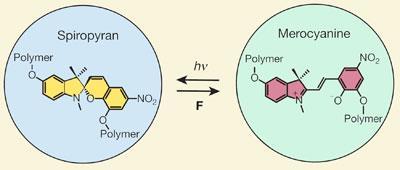A force-sensitive chemical moiety embedded in a polymer chain triggers a colour change when put under pressure
A new way to make force-sensitive polymers that respond to stress by changing colour has been designed by a multidisciplinary team in the US. They hope that their findings will prove useful as colour sensors to indicate early damage in climbing ropes and parachute cords, and will eventually lead to materials that can heal themselves after damage.
Nancy Sottos and co-workers, from the University of Illinois at Urbana-Champaign, US, have designed a polymer that has a force-sensitive chemical moiety - known as a mechanophore - embedded within the polymer chain. When the two ends of the polymer chain are pulled, this weak link in the centre is the first thing that gives. The moiety - spiropyran - itself doesn’t snap, but instead undergoes a selective ring-opening reaction to become linear.

Spiropyran is a well-known photochromic dye, used in commercially available lenses for spectacles that darken in sunny conditions. It is the ring opening reaction that causes the dye to change colour when exposed to light or force. ’When the bond is closed it is colourless, and when the bond is open it is red,’ explains Sottos. ’What is interesting about this too is that you can reverse it. If you close the bond, you remove the colour change,’ she adds.
While both the dye and the idea of using force to trigger a chemical reaction in a polymer is not new, ’the concept of linking [these mechanophores] into the polymer backbone and using force to trigger the reaction is a very new concept’, says Sottos.
The fact that the bond which opens is covalent is also interesting, says Sottos. Previous work in this area has been based around non-covalent interactions but covalent processes give you more power to do other things, she explains.
In the short-term this technique could be used to provide a sensing material that changes colour in response to damage, says Sottos. If you were able to spin the polymer into fibres and make a rope, for example, it could be used as a parachute cord or climbing rope that changes colour when it is over-stretched, signalling that it should not be used again. ’We also envisage coatings that change colour,’ she says, these could be used on bridges where a colour change would act as an early warning indicator that a bridge has become overloaded and unsafe.
![]()
Colour changes are just an initial step, says Sottos. The team hope to build on their concept and design more interesting force-sensitive chemical moieties than can induce more exciting reactions - such as a stress-induced cross linking or polymerisation. ’We are hoping that this might lead to a material that can heal itself or toughen when it comes under stress,’ Sottos explains.
Christoph Weder, an expert in novel functional materials from the University of Fribourg, Switzerland and Case Western Reserve University, Cleveland, US, is impressed by the work, saying it ’takes research on stress-induced chemical reactions to a different level’.
Other groups have done very similar things using force-sensitive materials in similar polymers, but they applied the stress by sonication of a solution containing the polymer and the mechanophore, he explains. ’As far as I know, this is the first paper that takes these concepts to the solid state.’
’My excitement is not really the stress sensing by colour change, which has been around for a while, but the fact that in principle you can use different chemical moieties in the centre of the polymer chain,’ says Weder. These different chemical groups could then be used to carry out different types of chemical processes when pulled apart, such as reactions that allow the material to heal itself, he explains.
According to Weder, however, there are some issues concerning this new concept that remain unresolved. ’The specific dyes that the team use are also photochromic,’ he says, meaning that light could confuse the sensor response. While also acknowledging that the team has done some good modelling work to show that the weak link is the result of a single bond, Weder points out that it is hard to really know how selective this chemistry is.
Nina Notman
Interesting? Spread the word using the ’tools’ menu on the left.
References
D A Davis et al, Nature, 2009. DOI:10.1038/nature07970






No comments yet